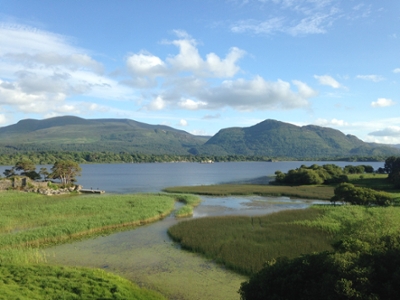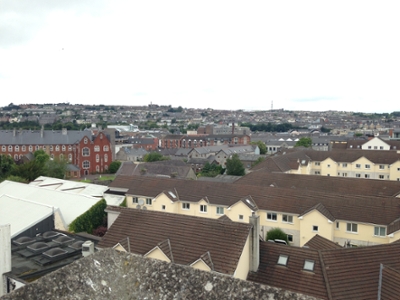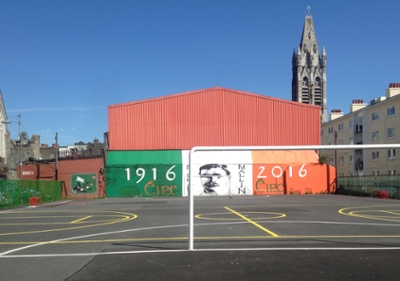PSF: History and Memory in Southwest Ireland

Isabel in Kilarney
The Kalem Company, which made nearly thirty silent films in Ireland from 1910 to 1915, was one of the first American film companies to shoot abroad, and the first to make silent fiction films in Ireland. In movies like The Lad from Old Ireland and The Colleen Bawn, Kalem director Sidney Olcott and his crew enacted stories of brave immigrants abroad and historic rebellions at home in scenic County Kerry.
Olcott and the rest of the company chose Beaufort, also in Kerry, as the base for their operations. Beaufort was also the hometown of Christie Sullivan, my great-grandmother. I came to Ireland this summer with the dual intention of researching and writing about life in Ireland during the early 20th century, when Christie was young and before she immigrated to the United States, and of investigating the Kalem company and filmic representations of Ireland by American filmmakers.
In County Kerry, I visited the Kerry Library’s Local History room, where I read issues of The Kerryman and other local newspapers from 1908 (the year Christie was born) to 1924 (the year she immigrated). I looked through folders full of photographs of the towns of Beaufort and Killarney. I walked the Gap of Dunloe, saw Kate Kearney’s cottage-turned-tavern, and stopped by the Muckross Estate. I visited Ross Castle, the former home of the Earl of Kenmare, converted into a tourist destination in the 19th century. All these places figured in Kalem films, and Kalem actress and scenario writer Gene Gauntier mentions them in her memoir. I peeked into the Beaufort Bar where the Kalem company stayed while in Ireland. Christie likely knew these places, and she likely heard stories of the Kalem visits from locals who had known the company, perhaps even acted as extras in their films.
 I also visited Cork, in the south of Ireland. The Kalem Company arrived in Ireland via the port at Cobh, then known as Queensland, just south of Cork. At the Cobh Heritage Centre, I learned that almost three million Irish emigrated from the same port between 1848 and 1950. Christie Sullivan was one of those immigrants. At the Cork County and City Archives, I read letters from Irish immigrants in San Francisco and Carson City, Nevada, to their relatives back home. I held a photocopied version of Cork mayor Terence MacSwiney’s tiny, near-illegible diary in my hands. A member of the Irish Volunteers, MacSwiney was arrested and died while on hunger strike in 1920, four years before my great-grandmother left the country.
I also visited Cork, in the south of Ireland. The Kalem Company arrived in Ireland via the port at Cobh, then known as Queensland, just south of Cork. At the Cobh Heritage Centre, I learned that almost three million Irish emigrated from the same port between 1848 and 1950. Christie Sullivan was one of those immigrants. At the Cork County and City Archives, I read letters from Irish immigrants in San Francisco and Carson City, Nevada, to their relatives back home. I held a photocopied version of Cork mayor Terence MacSwiney’s tiny, near-illegible diary in my hands. A member of the Irish Volunteers, MacSwiney was arrested and died while on hunger strike in 1920, four years before my great-grandmother left the country.
Next I took the train from Cork to Dublin, where I spent the final week of my trip, learning more about Gene Gauntier, the Kalems, and film history in Ireland. Before I arrived in Ireland, I’d wondered what Christie might have known about the Kalems when she was growing up in Beaufort. Would she have heard about Gauntier, a film industry pioneer and an actress who played Irish women? What was going to the movies like in early 20th century Ireland, and who would have been able to go see them? And— a larger question— how did Americans portray Ireland on film, and what did the Irish learn about America from the movies?
There are no definite answers to some of these questions. Instead, I hoped to learn enough to imagine, with some accuracy, various possibilities. In an effort to do so, I visited Dublin’s Irish Film Institute. The IFI made the Kalem films widely available on DVD, and the IFI library and archive have contributed to much research on the Kalems. In the IFI archive, I watched the Kalem films, movies about Killarney, and amateur films from the Institute’s collection. These sweet and sometimes beautiful home movies captured vacations, weddings, and landscapes, and gave me a sense of what daily life in the 1930s, after Christie left the country, might have looked like for some Irish folk. And in the IFI library, I learned that the first Irish movie theater opened in 1909, and cinemas soon opened up in Killarney and Tralee, not far from where Christie lived. She may not have visited these theaters, as travel and tickets might have been beyond her means. But movies, mostly American-made movies, made their way to the west of Ireland. She must have heard about them, and about the Kalems, too, from Beaufort folks who had acted in the movies. I wondered whether these movies in any way influenced Christie’s knowledge of the United States, her sense of what the country might be like, whether she heard about them from others in Beaufort.
possibilities. In an effort to do so, I visited Dublin’s Irish Film Institute. The IFI made the Kalem films widely available on DVD, and the IFI library and archive have contributed to much research on the Kalems. In the IFI archive, I watched the Kalem films, movies about Killarney, and amateur films from the Institute’s collection. These sweet and sometimes beautiful home movies captured vacations, weddings, and landscapes, and gave me a sense of what daily life in the 1930s, after Christie left the country, might have looked like for some Irish folk. And in the IFI library, I learned that the first Irish movie theater opened in 1909, and cinemas soon opened up in Killarney and Tralee, not far from where Christie lived. She may not have visited these theaters, as travel and tickets might have been beyond her means. But movies, mostly American-made movies, made their way to the west of Ireland. She must have heard about them, and about the Kalems, too, from Beaufort folks who had acted in the movies. I wondered whether these movies in any way influenced Christie’s knowledge of the United States, her sense of what the country might be like, whether she heard about them from others in Beaufort.
While in Dublin, I met with film historian and Trinity College professor Kevin Rockett, who spoke with me about American films made in Ireland, local theaters, and film censorship. I also attended one of Rockett’s lectures, which summarized film history in Ireland. I learned, for the first time, more about indigenous filmmaking and foreign film production in Ireland today.
 Even if I weren’t deliberately seeking out these histories, reminders of Ireland’s past would pop up anyway. Road signs and museum exhibitions alike feature writing in both English and Irish, a nod to the Gaelic Revival and efforts to revive a language that had nearly been blotted out by British colonization. Martellos, manors, and forts appear in cities and along random roadsides. Ignored and uninhabited, or renovated and accessible to tourists, these monuments call to mind centuries of colonial rule and a series of Irish rebellions, culminating in the 1916 Easter Rising in Dublin, and Irish independence in 1922. And since this year was the 100th anniversary of the Rising, the country, and Dublin in particular, were filled with murals, exhibitions, and commemorations of a year that fit squarely into the period I was concerned with.
Even if I weren’t deliberately seeking out these histories, reminders of Ireland’s past would pop up anyway. Road signs and museum exhibitions alike feature writing in both English and Irish, a nod to the Gaelic Revival and efforts to revive a language that had nearly been blotted out by British colonization. Martellos, manors, and forts appear in cities and along random roadsides. Ignored and uninhabited, or renovated and accessible to tourists, these monuments call to mind centuries of colonial rule and a series of Irish rebellions, culminating in the 1916 Easter Rising in Dublin, and Irish independence in 1922. And since this year was the 100th anniversary of the Rising, the country, and Dublin in particular, were filled with murals, exhibitions, and commemorations of a year that fit squarely into the period I was concerned with.
Now that I’m back in Oakland, California, I’m sometimes overwhelmed by all this history and information. I’ve been writing, taking notes, and transcribing letters and newspaper articles, but I feel at once like I have so much more to learn, and as if I already have more information than I could ever possibly cobble together into something coherent. Professor David Garrett once told our Labor History Latin America class that we should know more than we actually allude to in our writing. A writer should be so steeped in knowledge of their subject that most of what they know doesn’t make it into the final draft. As I write what is turning out to be a long essay about this experience, I find myself sneaking in tidbits of information that have no business being there—that deserve essays unto themselves—or heading back to books and websites and notes in search of more information. This summer has been a fascinating and challenging chance to craft an independent project that incorporates place, memory, people, and media of all kinds.
